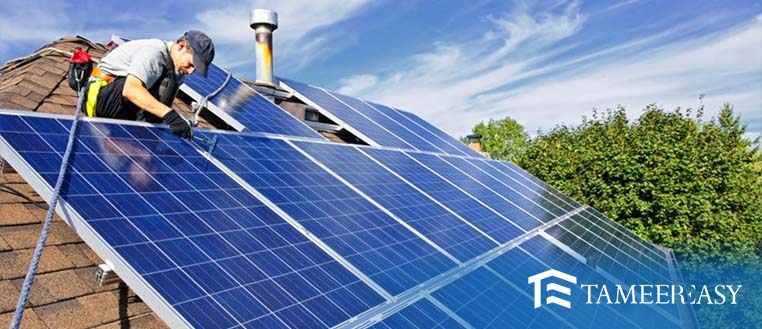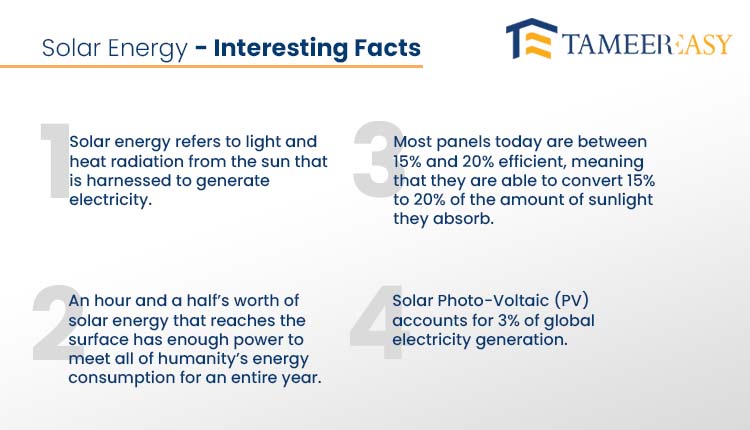When it comes to establishing a solar system, it’s not only about the cost; it’s also essential to be thoroughly aware of the difficulties involved in its installation. This way, regardless of who you hire to install your system, you can inquire about factors like the quality of the cables being used, the inverter and plates being installed, the panels being used, and the reason the structure is built a certain way to generate more and more uniform amounts of electricity.
Visit TameerEasy Store to Purchase Quality Construction Items
Solar engineers traditionally kept this information to themselves. However, we at the TameerEasy platform will give you access to all this data so that you can quickly complete every phase of the solar installation procedure. This will remove the worry that you will lose your hard earned money and guarantee that your system will supply you with electricity per your preferences.

Basic Solar System Installation Preparation
Here is the installation order for solar panels:
- A survey is first carried out.
- The design of the solar system is made.
- The panel has been chosen.
- Panel selection is followed by inverter selection.
- Next, a structure is chosen.
- On the sixth point, cable choice is made.
- The choice of safety equipment is the sixth point.
- The final step is selecting the distribution board, which is followed by the installation procedure.
Overview of Solar System Installation
- Customers are questioned about their load or how much electricity they use at any time when it comes to surveys. We convert that load into watts.
- The customer’s desire for a backup system is a crucial survey question, and depending on their response, we choose between on-grid, hybrid, or off-grid systems.
- After that, we focus primarily on two items when inspecting the roof. We first examine the available panel space on the roof, and then we examine the drainage system. This is crucial since you must routinely clean the plates with water after installation. Additionally, if the drainage system is subpar, water will begin to build up on the roof, potentially causing damage and spreading diseases like dengue fever.
- Following the survey, we plan the design, and using the data from the survey, we design the solar system and choose every product that will be utilised in it.
Choosing Products for the Installation of Solar Systems
- When it comes to choice, we start by discussing solar panels. Because they are produced using the most recent technology, solar panels should be Grade A and Tier 1.
- Because they produce more energy in a smaller area, panels should be more powerful. Currently, 400–650 watt plates may be found on the market.
- Check the warranty card and certificate, the brand name inscribed on the plate, the QR code, and the serial number.
- The decision regarding the inverter is made next after the panels. The inverter shouldn’t have any distortion. DC power from the plate is transformed into AC power by the inverter. An excellent inverter today has a 98% efficiency rate. This fact can be used to measure the inverter’s efficiency since it should supply all the electricity you require.
- The choice of the solar structure then needs to be made, and one that can survive all kinds of storms, winds, and rains should be chosen.
- During installation, special attention should be paid to its direction and angle, and its material should be at least 12 gauge and not rust-prone.
- Different types of solar structures include:
Fixed-angle Constructions: These are with a normally fixed tilt. These kinds of constructions are employed on broad, flat rooftops.
High-Rise External Structures: They’re utilised when there isn’t enough room on the roof or when the space is required for anything else, such as water tanks or the drying of clothing, etc.
Cable and Additional Safety Equipment
- Never skimp on the quality of the cable used in your solar system; this is crucial. This is because the system’s effectiveness is closely correlated with the calibre of the cable.
- Always choose double-insulated, 99.99% pure copper wires that can function well in temperatures between 90 and 120 degrees.
- The choice of safeguards then enters the picture, guarding the solar system and human life.
- It has a circuit breaker that isolates the current from your system in the event of a short circuit.
- In addition to breakers, you should install reputable brands of SPD to safeguard our system from internal harm brought on by abrupt high voltage.
- Additionally, install an earthing rod made of pure copper and a lightning arrester made of pure copper to defend against lightning strikes.
- Finally, choosing a DB (distribution board) is very important. All protective equipment should be included, such as breakers, SPDs, and changeovers.


Steps for Installing a Solar System
- Installing the solar structure comes first. Then, with nut bolts to secure them so that they can endure any severe wind or storm and prevent damage, solar panels are carefully put on them.
- The solar inverter is fitted, and its installation is examined with a leveller to ensure no slanting.
- Additionally, make sure that the inverter’s specs and drawing instructions are adhered to and that it is positioned correctly concerning its right, left, up, down, and vent directions following the instructions.
- Install the inverter close to the house’s distribution board (DB) to ensure that it is connected to a single or three-phase supply.
- Install the inverter’s DB, which also houses its safety devices and contains its breakers.
Procedure for Earthing in the Solar System
Earthing comes after the system has been installed. Earthing is essential to preserve the system’s pricey equipment and shield people from electric shock.
Consequently, it is crucial to ground any metallic component in our system. Since a solar system generates AC and DC electricity, each must be earthed individually using earthing rods.
Setting up an Earthing System
- First, the entire DC component, which consists of the roof’s solar panels and plates, is connected, and a wire is thimble-attached to it.
- An earthing rod is then used to ground this wire. We now need to drill an appropriate earthing bore for this earthing rod. This bore should be as deep as the beginning of the damp soil.
- The bore is then filled with the removed soil once the earthing rod and cable have been inserted.
- However, it is better practice to add earthing powder after drilling the bore instead of filling it back up.
This completes all of the earthing for our roof-mounted system.
Grounding for the Inverter
We will ground the inverter using both techniques because it receives AC and DC power from within. By connecting a wire to it and grounding it with an earthing rod, we will apply the same grounding technique as for the AC component. Try to ground the AC component independently; however, you can also ground both components via a cable.
Surge arresters are additionally grounded in addition to this. Surge arresters are positioned on the roof just above the solar panels. The surge arresters’ grounding points are connected to cables, which are lowered to the ground and grounded there. Additionally, these wires are individually grounded with an earthing rod.
Choice of Materials for Earthing Cables
- We should employ larger cables, especially in our system where DC cables are used. Additionally, if we’re going to cut costs, we should use cables the same size as the DC cables our system is now using. DC cable, in this context, refers to the cable that connects the solar panels to the inverter.
- Checking the Earthing
- We run an Earth Resistance test to verify the grounding. In this experiment, we measure the Earth’s resistance to see how much it is. Our grounding is flawless if the resistance reading is 5 ohms or less.
Importance of Solar System Wiring
Wiring is crucial when installing a solar system since it directly impacts the system’s overall efficiency.
Here are some crucial ideas to bear in mind throughout this process:
- We connect panels in series and parallel based on the minimum and maximum voltages indicated in the inverter’s specifications.
- Make sure the wiring is tight and free of loose connections.
- Our wiring needs to be coded appropriately and tagged to make it understandable to anyone who wants to work on the system in the future.
- Proper labelling is also crucial to prevent the wiring from being exposed to the elements directly. For instance, if we are discussing a rooftop installation, the wire shouldn’t be exposed to the elements directly. Instead, it should be routed through the appropriate PVC pipes to shield it from moisture, humidity, and sunshine. This prolongs the cable’s life and guarantees that it will operate correctly.
- After the wiring is finished, any Wi-Fi device can be connected to the inverter by following the instructions on the device.
- Typically, Wi-Fi devices are used for online monitoring, enabling you to view the system’s output and other information on your mobile phone from any location.
Essential Checks to Make Before Starting the Solar System
Before turning the solar system on, pre-commissioning is crucial.
- We must first inspect our wiring. The wiring shouldn’t have any loose connections. Here are some crucial details you need to keep in mind:
- To fasten the screws, the reasonable force must be used.
- Then, we determine if it is unrelated to positive-positive or negative-negative.
- The system’s correct earthing is then verified if it has been done at all.
- Once everything is verified, we proceed to the commission, which entails turning on the system.
- An AC and DC supply power on the system first, and then we input data about the nation, date, time, grid, etc.
- If your inverter offers a feature for online monitoring, you must configure the Wi-Fi connection.
- Download the suggested app on your phone, set it up inside the inverter, and link it to your home’s Wi-Fi. Through this software, you can also keep tabs on it online.
Other Solar System Precautionary Measures
Cleaning is the most crucial factor for solar panels. Many claim that while the system was functioning well initially, it is less effective. Essentially, they are not maintaining the cleanliness of the panels, and dirt is settling on the surface.
Since solar panels use sunlight to create electricity, dust buildup prevents them from performing as intended. They are unable to produce electricity as a result. As a result, the panels need to be cleaned once a week.
Final Thoughts
So, this was a thorough instruction for installing a solar system at your home or business. We hope that you have acquired all the knowledge required to oversee the entire process. You can contact us through our website, tameereasy.com if you still need clarification.







